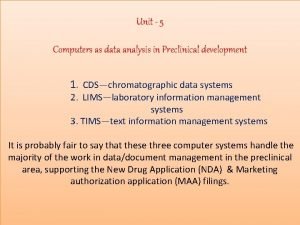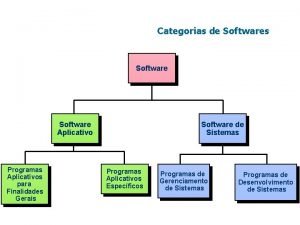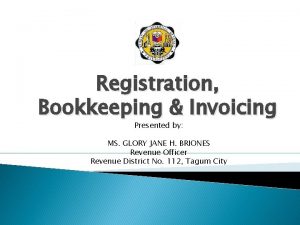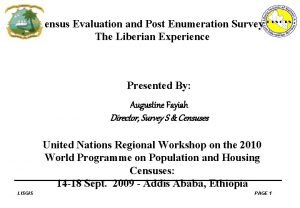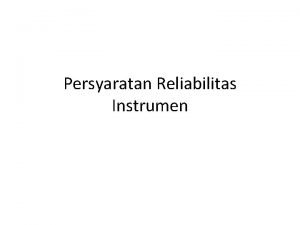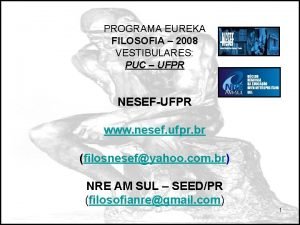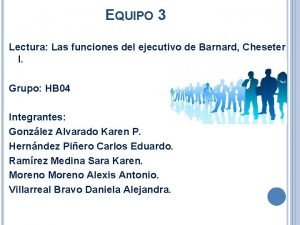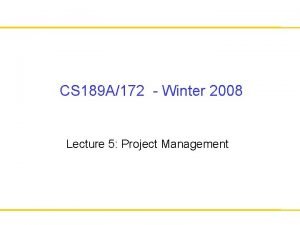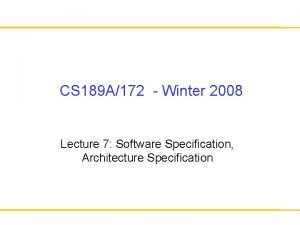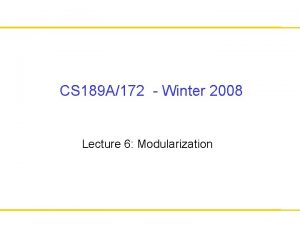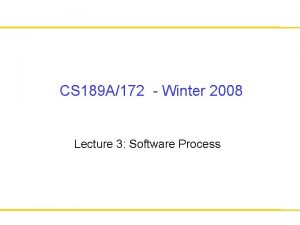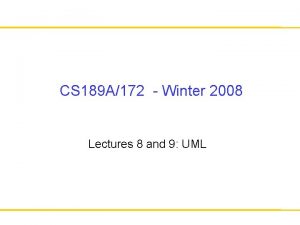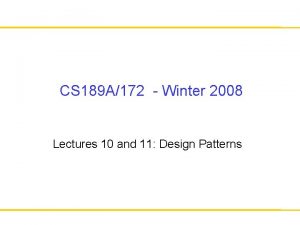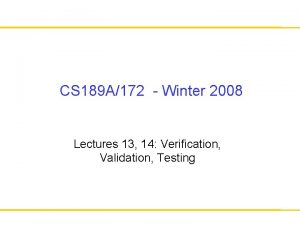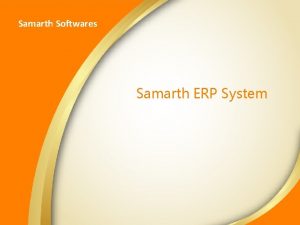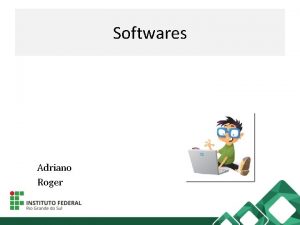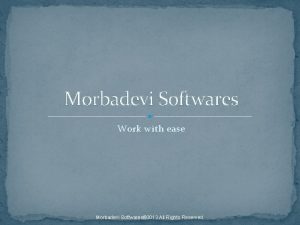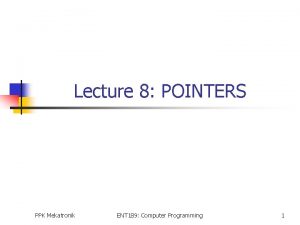CS 189 A172 Winter 2008 Lecture 2 Softwares




























- Slides: 28

CS 189 A/172 - Winter 2008 Lecture 2: Software’s Chronic Crisis (No Silver Bullet)

First Three Assignments • All the teams must be formed by the beginning of 2 nd week of classes, Monday, January 14 – You have to form your teams in the first week and pick a project • Each team must prepare a 1 -2 page vision statement about the project describing, due Friday, January 19 th – what the project is about – what will be the outcome of the project – what will be the implementation platform • A team member from each team is going to present this vision statement to the class on Friday, January 19 th

Reading Assignments • First Week – “Software’s Chronic Crisis, ’’ by W. Wayt Gibbs. Scientific American, Sept. 94, pp. 85 -96. – “No Silver Bullet: Essence and Accidents of Software Engineering, ” by Frederick P. Brooks, IEEE Computer, vol 10, no. 4, April 1987, pp. 10 -19. • Second Week – “How Microsoft Builds Software, ” by M. A. Cusumano and R. W. Selby, Communications of the ACM, vol. 40, no, 6, June 1997, pp. 53 -61. – “Embracing Change with Extreme Programming, ” by Kent Beck, IEEE Computer, October 1999, pp. 70 -77.

Software Engineering • In 1968 a seminal NATO Conference was held in Germany. – Purpose: to look for a solution to software crisis – 50 top computer scientists, programmers and industry leaders got together to look for a solution to the difficulties in building large software systems (i. e. , software crisis) – The term “software engineering” was first used in that conference to indicate a systematic, disciplined, quantifiable approach to the production and maintenance of software • Three-decades later (1994) an article in Scientific American (Sept. 94, pp. 85 -96) by W. Wayt Gibbs was titled: – “Software’s Chronic Crisis’’

Software’s Chronic Crisis Large software systems often: • Do not provide the desired functionality • Take too long to build • Cost too much to build • Require too much resources (time, space) to run • Cannot evolve to meet changing needs – For every 6 large software projects that become operational, 2 of them are canceled – On the average software development projects overshoot their schedule by half – 3 quarters of the large systems do not provide required functionality

Software Failures • There is a long list of failed software projects and software failures • You can find a list of famous software bugs at: http: //www 5. in. tum. de/~huckle/bugse. html • I will talk about two famous and interesting software bugs

Ariane 5 Failure • A software bug caused European Space Agency’s Ariane 5 rocket to crash 40 seconds into its first flight in 1996 (cost: half billion dollars) • The bug was caused because of a software component that was being reused from Ariane 4 • A software exception occurred during execution of a data conversion from 64 -bit floating point to 16 -bit signed integer value – The value was larger than 32, 767, the largest integer storeable in a 16 bit signed integer, and thus the conversion failed an exception was raised by the program • When the primary computer system failed due to this problem, the secondary system started running. – The secondary system was running the same software, so it failed too!

Ariane 5 Failure • The programmers for Ariane 4 had decided that this particular velocity figure would never be large enough to raise this exception. – Ariane 5 was a faster rocket than Ariane 4! • The calculation containing the bug actually served no purpose once the rocket was in the air. – Engineers chose long ago, in an earlier version of the Ariane rocket, to leave this function running for the first 40 seconds of flight to make it easy to restart the system in the event of a brief hold in the countdown. • You can read the report of Ariane 5 failure at: http: //www. ima. umn. edu/~arnold/disasters/ariane 5 rep. html

Mars Pathfinder • A few days into its mission, NASA’s Mars Pathfinder computer system started rebooting itself – Cause: Priority inversion during preemptive priority scheduling of threads • Priority inversion occurs when – a thread that has higher priority is waiting for a resource held by thread with a lower priority • Pathfinder contained a data bus shared among multiple threads and protected by a mutex lock • Two threads that accessed the data bus were: a high-priority bus management thread and a low-priority meteorological data gathering thread • Yet another thread with medium-priority was a long running communications thread (which did not access the data bus)

Mars Pathfinder • The scenario that caused the reboot was: – The meteorological data gathering thread accesses the bus and obtains the mutex lock – While the meteorological data gathering thread is accessing the bus, an interrupt causes the high-priority bus management thread to be scheduled – Bus management thread tries to access the bus and blocks on the mutex lock – Scheduler starts running the meteorological thread again – Before the meteorological thread finishes its task yet another interrupt occurs and the medium-priority (and long running) communications thread gets scheduled – At this point high-priority bus management thread is waiting for the lowpriority meteorological data gathering thread, and the low-priority meteorological data gathering thread is waiting for the medium-priority communications thread – Since communications thread had long-running tasks, after a while a watchdog timer would go off and notice that the high-priority bus management thread has not been executed for some time and conclude that something was wrong and reboot the system

Software’s Chronic Crisis • These are not isolated incidents: – IBM survey of 24 companies developing distributed systems: • 55% of the projects cost more than expected • 68% overran their schedules • 88% had to be substantially redesigned

Capability Maturity Model • Software Engineering Institute at CMU (http: //www. sei. cmu. edu/cmm. sum. html) • Maturity levels used to evaluate software development processes – 1) Initial. The software process is characterized as ad hoc, and occasionally even chaotic. Few processes are defined, and success depends on individual effort and heroics. – 2) Repeatable. Basic project management processes are established to track cost, schedule, and functionality. The necessary process discipline is in place to repeat earlier successes on projects with similar applications. – 3) Defined. The software process for both management and engineering activities is documented, standardized, and integrated into a standard software process for the organization. All projects use an approved, tailored version of the organization's standard software process for developing and maintaining software. – 4) Managed. Detailed measures of the software process and product quality are collected. Both the software process and products are quantitatively understood and controlled. – 5) Optimizing. Continuous process improvement is enabled by quantitative feedback from the process and from piloting innovative ideas and technologies. • In 1994, 75% of of the companies they evaluated were at level 1

Software’s Chronic Crisis • Software product size is increasing exponentially – faster, smaller, cheaper hardware • Software is everywhere: from TV sets to cell-phones • Software is in safety-critical systems – cars, airplanes, nuclear-power plants • We are seeing more of – distributed systems – embedded systems – real-time systems • These kinds of systems are harder to build • Software requirements change – software evolves rather than being built

Summary • Software’s chronic crisis: Development of large software systems is a challenging task – Large software systems often: Do not provide the desired functionality; Take too long to build; Cost too much to build Require too much resources (time, space) to run; Cannot evolve to meet changing needs • Software engineering focuses on addressing challenges that arise in development of large software systems using a systematic, disciplined, quantifiable approach

No Silver Bullet • In 1987, in an article titled: “No Silver Bullet: Essence and Accidents of Software Engineering” Frederick P. Brooks made the argument that there is no silver bullet that can kill the werewolf software projects • Following Brooks, let’s philosophize about software a little bit

Essence vs. Accident • Essence vs. accident in software development – We can get rid of accidental difficulties in developing software – Getting rid of these accidental difficulties will increase productivity • For example using a high level programming language instead of assembly language programming – The difficulty we remove by replacing assembly language with a high-level programming language is not an essential difficulty of software development, • It is an accidental difficulty brought by inadequacy of assembly language for programming

Essence vs. Accident • Essence vs. accident in software development – Brooks argues that software development is inherently difficult • “The essence of a software entity is a construct of interlocking concepts: data sets, relationships among data items, algorithms and invocations of functions. This essence is abstract in that such a conceptual construct is the same under many different representations. . The hard part of building software is the specification, design, and testing of this conceptual construct, not the labor of representing it and testing the fidelity of the representation. ” • Even if we remove all accidental difficulties which arise during the translation of this conceptual construct (design) to a representation (implementation), still at its essence software development is difficult

Inherent Difficulties in Software • Software has the following properties in its essence: – Complexity – Conformity – Changeability – Invisibility • Since these properties are not accidental representing software in different forms do not effect them • The moral of the story: – Do not raise your hopes up for a silver bullet, there may never be a single innovation that can transform software development as electronics, transistors, integrated-circuits and VLSI transformed computer hardware

Complexity • Software systems do not have regular structures, there are no identical parts • Identical computations or data structures are not repeated in software • In contrast, there is a lot of regularity in hardware – for example, a memory chip repeats the same basic structure millions of times

Complexity • Software systems have a very high number of discrete states – Infinite if the memory is not bounded • Elements of software interact in a non-linear fashion • Complexity of the software increases much worse than linearly with its size

Complexity • Consider a plane that is going into a wind-tunnel for aerodynamics tests – During that test it does not matter what is the fabric used for the seats of the plane, it does not even matter if the plane has seats at all! – Only thing that matters is the outside shape of the plane – This is a great abstraction provided by the physical laws and it helps mechanical engineers a great deal when they are designing planes • Such abstractions are available in any engineering discipline that deals with real world entities • Unfortunately, software engineers do not have the luxury of using such abstractions which follow from physical laws – Software engineers have to develop the abstractions themselves (without any help from the physical laws)

Conformity • Software has to conform to its environment – Software conforms to hardware interfaces not the other way around • Most of the time software systems have to interface with an existing system • Even for a new system, the perception is that, it is easier to make software interfaces conform to other parts of the system

Changeability • Software is easy to change, unlike hardware • Once an Intel processor goes to the production line, the cost of replacing it is enormous (Pentium bug cost half billion dollars) • If a Microsoft product has a bug, the cost of replacing it is negligible. – Just put the new download on a webpage and ask users to update their software

Changeability is not an Advantage • Although it sounds like, finally, software has an advantage over hardware, the effect of changeability is that there is more pressure on changing the software • Since software is easy to change software gets changed frequently and deviates from the initial design – adding new features – supporting new hardware

Changeability • Conformity and Changeability are two of the reasons why reusability is not very successful in software systems • Conformity and Changeability make it difficult to develop component based software, components keep changing

Invisibility • • Software is invisible and un-visualizable Complete views can be incomprehensible Partial views can be misleading All views can be helpful • Geometric abstractions are very useful in other engineering disciplines – Floor plan of a building helps both the architect and the client to understand evaluate a building • Software does not exist in physical space and, hence, does not have an inherent geometric representation

Invisibility • Visualization tools for computer aided design are very helpful to computer engineers – Software tools that show the layout of the circuit (which has a twodimensional geometric shape) makes it much easier to design a chip • Visualization tools for software not as successful – There is nothing physical to visualize, it is hard to see an abstract concept – There is no physical distance among software components that can be used in mapping software to a visual representation – UML and similar languages are making progress in this area

Summary • According to Brooks, there are essential difficulties in software development which prevents significant improvements in software engineering: – Complexity; Conformity; Changeability; Invisibility • He argues that an order of magnitude improvement in software productivity cannot be achieved using a single technology due to these essential difficulties
 Futuretech softwares
Futuretech softwares Which software
Which software Benefits of text information management system slideshare
Benefits of text information management system slideshare Rogério morais
Rogério morais Softwares can_ -in designing and modeling in every field
Softwares can_ -in designing and modeling in every field Ciberrroubo
Ciberrroubo 2008 2008
2008 2008 Winter kommt winter kommt flocken fallen nieder
Winter kommt winter kommt flocken fallen nieder Heute mittwoch guten morgen mittwoch winter
Heute mittwoch guten morgen mittwoch winter Was ist deine lieblingsjahreszeit
Was ist deine lieblingsjahreszeit 01:640:244 lecture notes - lecture 15: plat, idah, farad
01:640:244 lecture notes - lecture 15: plat, idah, farad Who can cheer the heart like jesus
Who can cheer the heart like jesus Calea vacaresti 189
Calea vacaresti 189 The word that has 189 819 letters
The word that has 189 819 letters God vaart voor het oog met gejuich omhoog
God vaart voor het oog met gejuich omhoog Weerklank 189
Weerklank 189 Cs 189 berkeley
Cs 189 berkeley Calea vacaresti 189
Calea vacaresti 189 Pearson education 2008
Pearson education 2008 Rmc 13-82
Rmc 13-82 Liberia census 2008 results
Liberia census 2008 results Rys 9 1998
Rys 9 1998 2008 pearson education inc
2008 pearson education inc Green section of erg
Green section of erg Sukardi 2008
Sukardi 2008 Puc pr 2008 para aristoteles em etica a nicomaco
Puc pr 2008 para aristoteles em etica a nicomaco C-2008
C-2008 En el 2008
En el 2008 2008
2008


